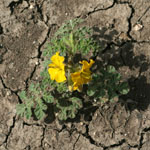Buffalo burr
Common name:
- Buffalo burr
Scientific name:
- Solanum rostratum Dunal
Plant status
Catchment management authority boundaries
Regionally prohibited in the Wimmera, North East, Port Phillip and Westernport catchments.
Regionally controlled in the Goulburn Broken catchment.
Restricted in the Mallee, Glenelg Hopkins, North Central, Corangamite, West Gippsland and East Gippsland catchments.
Plant biology

Appearance
Herbaceous plant — Forb (flowering herbaceous plant — not a grass)
Description
Buffalo burr is an annual herb.
Stems
Stems are multi-branched and erect growing to 50cm high. Stems become woody as the plant matures. They are hairy with yellow prickles to 1.5cm long.
Leaves
Leaves are dark green with deeply and irregularly lobed edges. Lobes are rounded rather than pointed.

Flowers
Flowers are yellow with a densely prickled calyx, 2 to 3cm in diameter. Flowers form in clusters of up to 10 flowers with 5 petals and 5 stamens.
Fruit
Fruit is a globular or ovoid berry, black when ripe and 1 to 1.5cm in diameter, enclosed in a prickly calyx.
Growth and lifecycle

Method of reproduction and dispersal
The plant is dispersed by seed.
Burrs can stick to wool and float on water.
Buffalo burr is also spread by strong wind blowing plant parts along the ground as tumbleweeds.
Rate of growth and spread
Buffalo burr germinates in autumn, grows in winter and flowers in late spring and summer. The weed takes less than a year to become productive.
Seedbank propagule persistence
Seed viability for Buffalo burr is unknown.
Preferred habitat
Buffalo burr grows in sandy soil as well as hard, compacted clay soils. It occurs in over-grazed pasture, cropping situations and establishes in growing crops, open fields and pastures.
The weed is tolerant to waterlogging and drought.
Distribution
The plant is generally confined to the wheat belt, but is also known to grow on flood plains.
Growth calendar
The icons on the following table represent the times of year for flowering, seeding, germination, the dormancy period of Buffalo burr and also the optimum time for treatment.
| Jan | Feb | Mar | Apr | May | Jun | Jul | Aug | Sep | Oct | Nov | Dec | |
|---|---|---|---|---|---|---|---|---|---|---|---|---|
| Flowering | ||||||||||||
| Seeding | ||||||||||||
| Germination | ||||||||||||
| Dormancy | ||||||||||||
| Treatment |
Impact
Agricultural and economic impacts
Buffalo burr occurs in pastures. Grazing may be affected as animals will avoid the plant's prickles. It is a problem in grain growing and wheat belt areas as seed can contaminate the grain. Burrs from the plant can stick to wool, causing problems with wool quality. The weed is potentially a host for tomato and tobacco nematodes.
Management
Prescribed measures for the control of noxious weeds:
- application of a registered herbicide
- physical removal.
Read about prescribed measures for the control of noxious weeds.
Other management techniques
Changes in land use practices and spread prevention may also support buffalo burr management after implementing the prescribed measures.